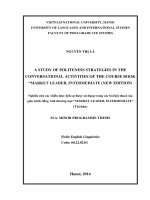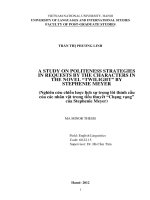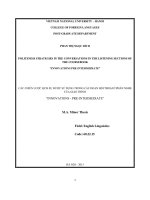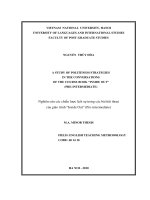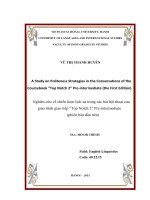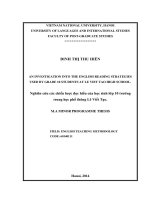a study of politeness strategies in the conversational activities of the coursebook - new headway, intermediate = nghiên cứu các chiến lược lịch sự có trong các bài hội thoại của giáo trình giao tiếp
Bạn đang xem bản rút gọn của tài liệu. Xem và tải ngay bản đầy đủ của tài liệu tại đây (599.31 KB, 47 trang )
VIETNAM NATIONAL UNIVERSITY, HANOI
UNIVERSITY OF LANGUAGES AND INTERNATIONAL STUDIES
DEPARTMENT OF POST- GRADUATE STUDIES
***
TRIỆU THỊ TRANG
A STUDY OF POLITENESS STRATEGIES IN THE
CONVERSATIONAL ACTIVITIES OF THE
COURSEBOOK –
NEW HEADWAY, INTERMEDIATE.
(NGHIÊN CỨU CÁC CHIẾN LƯỢC LỊCH SỰ CÓ TRONG CÁC BÀI HỘI THOẠI CỦA
GIÁO TRÌNH GIAO TIẾP “NEW HEADWAY, INTERMEDIATE.”)
M.A. MINOR THESIS
FIELD: ENGLISH LINGUISTICS
CODE: 602215
Hanoi-2009
VIETNAM NATIONAL UNIVERSITY, HANOI
UNIVERSITY OF LANGUAGES AND INTERNATIONAL STUDIES
DEPARTMENT OF POST- GRADUATE STUDIES
***
TRIỆU THỊ TRANG
A STUDY OF POLITENESS STRATEGIES IN THE
CONVERSATIONAL ACTIVITIES OF THE
COURSEBOOK –
NEW HEADWAY, INTERMEDIATE.
(NGHIÊN CỨU CÁC CHIẾN LƯỢC LỊCH SỰ CÓ TRONG CÁC BÀI HỘI THOẠI CỦA
GIÁO TRÌNH GIAO TIẾP “NEW HEADWAY, INTERMEDIATE.”)
M.A. MINOR THESIS
FIELD: ENGLISH LINGUISTICS
CODE: 602215
Supervisor: Prof. NGUYEN QUANG (Ph.D.)
Hanoi-2009
iv
TABLE OF CONTENTS
Contents
Pages
* Abstract
i
* Acknowledgements
ii
* Lists of Abbreviations, tables and figures
iii
Part I. Introduction
1
I. Rationale
1
II. Aims of the Study
2
III. Scope of the study
2
IV. Methodology
2
V. Design of the study
3
Part II. Development
4
Chapter 1: Theoretical background
4
I.1. Speech Acts
4
I.1.1. Direct and indirect speech acts
6
I.2 Politeness
7
I.2.1. Face
8
I.2.1.1. Positive face
8
I.2.1.2. Negative face
9
I.2.2. Politeness strategies
9
I.2.2.1. Positive Politeness and Positive Politeness Strategies
11
I.2.2.2. Negative Politeness and Negative Politeness Strategies
14
Chapter 2: Positve and Negative Politeness strategies in Conversational
activities in the coursebook “New Headway, ntermediate”
17
II.1. Frequency of occurrence of Politeness strategies
17
II.2. Positive and negative politeness strategies in conversational activities
in twelve units of the coursebook “New Headway, Intermediate”
20
II.2.1. Positive politeness strategies in conversational activities in twelve
units of the coursebook “New Headway, Intermediate”
20
II.2.2. Negative politeness strategies in conversational activities in twelve
units of the coursebook “New Headway, Intermediate”
25
II. 2.3. Concluding remarks
29
Chapter 3: Implications for teaching the coursebook
30
III.3.1. Implications for ELT
30
III.3.2. Some recommendations
31
III.3.3. Some sample exercises and activities
31
Part III. Conclusion
37
I. Summary
37
II. Suggestions for further study
38
* References
I
* Appendix
III
iii
LIST OF ABBREVIATIONS
C.A: Conversational Activity
EFL: English as a Foreign Language
ELT: English Language Teaching
FTA: Face Threatening Act
H: Hearer
NPS: Negative Politeness Strategy
P.S. Politeness Strategy
PPS: Positive Politeness Strategy
S.A: Speech Act
S: Speaker
LIST OF TABLES AND FIGURES
Figure 1. Circumstances determining choice of strategies. (P. Brown and S.C. Levinson,
1987:60)
Figure 2: Strategies to mininze risk of losing face (Nguyen Quang, 2001)
Table 1: Statistics of positive and negative politeness strategies in each CA.
Figure 3: Frequency of negative and positive politeness strategies found in the
conversations.
Table 2: Statistics of the frequency of positive politeness strategies.
Figure 4: Frequency of positive politeness strategies used in the conversations.
Table 3: Statistics of the frequency of negative politeness strategies
Figure 5: Frequency of negative politeness strategies used in the onversations.
1
PART I: INTRODUCTION
1. Rationale.
The English language seems to take over the world in the course of the twenty –
first century and become the global language. Nowadays, English has played an
important role in our daily life and made a considerable contribution to education,
culture, business, science and technology. The number of people learning English for
various purposes such as job, business, traveling is continually on the increase
everyday. Therefore, variety kinds of English teaching and learning materials are
available all over the world, especially in Vietnam.
In Vietnam, English has been regarded as the most important foreign language
nowadays, especially since the Vietnamese Government carried out the open – door
policy. English then becomes a compulsory subject in most schools, colleges and
universities throughout the country. However, the emphasis on transmission of
structural rules and forms often serves as the principle method of teaching English in
Vietnam. Therefore, most Vietnamese teachers tend to focus more on grammar rather
than on communication. But this method, in fact, can not do much help for students to
assure a successful cross- cultural communication in daily life. The students may get
difficulty in achieving contextual, situational and cultural appropriateness in
communication. As a consequence, culture shock and communication breakdown
might happen in communication even though students are good at English grammar.
Obviously, cultural knowledge is an important key to success in learning English
because second language learning is second culture learning. In order to acquire the
second foreign language – English, it is necessary to learn not only linguistic
knowledge and interaction skills but also knowledge of the target culture. Cultural
factors are included in the course designs in many schools and universities today.
Understanding cultural factors gives students chances to expose themselves to the
target environment. Vietnamese students normally tend to employ English based on
their native culture and thus, it easily causes misinterpretation, misunderstanding and
misbehavior in cross-cultural communication. They sometimes appear impolite,
unfriendly or even rude, in spite of themselves.
2
Therefore, for successful international communication, learners of English must be
aware of not only their own culture but English speaking cultures as well, especially
the hidden parts of culture including face, facework and politeness. Politeness is really
a vital part of all social interactions.
The author of this study aims to investigate and highlight the important role of
positive and negative politeness strategies in the conversational activities of the course
book “New – Headway, Intermediate” by Liz & John Soars so as to improve the
teaching and learning of verbal communication in English for the third – year students
of the University of Labour and Social Affairs.
2. Aims of the study:
The aims of the study are:
- To study positive and negative politeness strategies in most typical contextual
environments in the conversational activities of the course book “New – Headway,
Intermediate”.
- To collect and design sample cross – cultural activities and exercises to raise
students’ cross- cultural awareness.
- To suggest effective and efficient ways of teaching the course book “New
Headway”
3. Scope of the study:
This study focuses on the realization of positive and negative politeness strategies
found in the conversational activities (twelve units) of the course book “New –
Headway, Intermediate”.
4. Methodology:
The major method that the author has employed is quantitative with due reference
to qualitative method since this study focuses on the practical aspects of cross – cultural
communication. All the considerations and conclusions are based on analysis and
reference. The main approaches are:
- Reference to publication;
- Discussion with supervisor;
3
- Discussion with colleagues;
- Personal observations
5. Design of the study
The study is divided into three parts:
Part I: Introduction which includes Rationale, Aims of the study, Scope of the study
and Methodology.
Part II. Development
Which covers three chapters, the first chapter focuses on the theoretical background of
speech acts, politeness and politeness strategies; the second chapter analyses the
positive and negative politeness strategies in the conversational activities in the course
book – New Headway, Intermediate through the frequency of its occurrences. The last
chapter offers some implications for learning and teaching politeness strategies for the
third- year students of ULSA.
Part III. Conclusion which summarizes the main findings and giving suggestions for
further study.
4
PART II: DEVELOPMENT
Chapter 1: THEORETICAL BACKGROUND
I.1. Speech acts (SA)
One of the concepts which have attracted many linguists and scientists in the study
of language usage is that of speech acts. Green (1975) emphasizes that speech acts are
viewed and performed differently in different cultures. In fact, it has been proved that
people in different cultures choose alternative ways to express speech acts. These
differences in many cases proved, lead to misunderstanding and miscommunication in
cross – cultural interaction.
The theory of speech acts studies the relations between language symbols and their
use for communication purposes. Austin (1962) is the first to initiate the theory of
speech acts. In his very influential book, How to Do Things with Words, Austin (1962),
observes that in saying something that has a certain sense and reference, one is
normally doing something other than just saying something like making a request or
making a promise or an offer, etc. According to Austin, there are three types of acts:
* Locutionary acts: A locutionary act is the performance of an actual utterance and its
ostensible meaning, comprising phonetic, phatic and rhetic acts.
E.g: He said to me “The door is here!”
* Illocutionary acts: Illocutionary act is an act performed in saying something, it is
closely connected with the speaker’s intention such as stating, questioning, promising,
giving commands, threatening and many others. Illocutionary acts are considered the
core of the theory of speech acts. Basically, illocutionary act indicates how the whole
utterance is to be taken into the conversation. Sometimes it is not easy to determine
what kind of illocutionary act the speaker performs, therefore, in order to correctly
decode the illocutionary act performed by the speaker, it is also necessary for the
hearer to be acquainted with the context the speech act occurs in.
Let’s analyse the example: “The door is here”. This simple declarative sentence can
be interpreted in at least two ways. It can be either understood literally a reply to the
question “Where is the way out?” or possibly “Where is the door?” or it can be taken as
an indirect request to ask somebody to leave. The sentence has thus got two
illocutionary forces: direct speech act and indirect speech act.
5
In order to have better understanding and orientation about illocutionary acts, many
linguists proposed their classification. Sharing with Autin’s view on SA classification,
Searle (1983: 240) divides illocutionary acts into five major categories:
+ Declaratives: The speaker brings about some state of affairs by virtue of the utterance
itself. The performance of the act brings about a change in the world. This class
includes declarations such as baptisms, pronouncing someone guilty or pronouncing
someone husband and wife.
+ Assertive: The speaker believes that the proposition expresses actual state of affairs,
including complaints, accusations, etc.
+ Directives: The speaker attempts to get the hearer to carry out a future course of
action. This class consists of requests, commands and advice, etc.
+ Commissives: The speaker becomes committed to doing some future action, e.g.
promises, guarantees, oaths, etc.
+ Expressives: Speech acts that express on the speaker's attitudes and emotions towards
the proposition, e.g. congratulations, excuses, thanks, etc.
* Perlocutionary acts: Perlocutionary acts can be described in terms of the level of their
psychological consequences, often performing an act by saying something such as
persuading, convincing, scaring, enlightening, inspiring, or otherwise getting someone
to do or realize something.
E.g: Would you open the door?
The act is successful if the hearer recognizes that he should open the door. As a
perlocutionary act it succeeds only if the hearer actually opens the door.
As another example, consider the following utterance: "By the way, I have a CD of
Westlife; would you like to borrow it?" Its illocutionary function is an offer, while its
intended perlocutionary effect might be to impress the listener, or to show a friendly
attitude, or to encourage an interest in a particular type of music.
6
There are many utterances with the purposes to effect the hearer in some ways or
other, some convey the information directly, others are more careful and polite so they
employ indirectness to transmit the message.
I.1.1. Direct and indirect speech acts.
I.1.1.1. Direct speech acts.
One of the remarkable issues in the study of speech acts is the difference between
direct and indirect speech acts. A direct speech act can be performed by using
sentences literally or using implicit performative sentences. Directness requires a good
feeling for the situation, however, being too direct when stating the opinion might seem
like an insult, especially if the hearer perceives the speaker as being lower in the social
hierarchy. Direct commands, of course, can easily sound like that the speaker is
bossing people around.
E.g: “Give me the sweater!”
“Where is the carpark?”
Asking direct questions from someone may make hearers feel that the speaker is
being nosy or intrusive. Furthermore, they might feel the S is forcing them to be rude
by asking a question they cannot skate over and must answer with a direct “I don’t
want to tell you.”
Nevertheness, the relationships between speakers and hearers play important parts
in communicating. Obviously, a mother would have no problem saying those things to
her seven-year-old, for two reasons: One, the two are socially very close to each other
and two, the mother is higher in the social hierarchy than the seven-year-old. But if a
stranger walks up to someone on the street and says those things, the hearer might feel
offended. Politeness rules dictate that increase in social distance requires more
indirectness. Directness often marks closeness between equals, because the speaker
trust them enough to interpret his message at face value and need not read some
hidden criticism into it.
7
I.1.1.2. Indirect speech acts.
According to Searle (1969) “In indirect speech acts, the speaker communicates to
the hearer more than s/he actually says by way of relying on their mutually shared
background information, both linguistic and nonlinguistic, together with the general
powers of rationality and inference on the part of the hearer.” Indirectness seems to be
very useful in socially distant situations. It may be unacceptable if the speaker employs
such utterances with strangers or with the person who is in higher social rank and
power. In such cases, indirectness can be a better choice. Instead of using directness
like: “Give me the sweater!” or “Where is the carpark?” To be more polite, the
speaker should use the indirectness such as: “Can you give me the sweater?” or “Could
you please give me the sweater?” and “Can you tell me where the carpark is?” or “Do
you know where the carpark is?” or so on by using conventional indirectness with
modal verbs, questions, hedges,… in the utterances.
Showing indirectness in the conversational interactions often exposes politeness.
According to Blum- Kulka (1987), politeness is, in the light of functional and
pragmatic approach, basically, a function of redress action which is related to
“indirectness”. Sharing with Kulka’s view, Nguyen Quang (2003) proposes that
“Politeness” seems to be related to “conventional indirectness” but not necessarily to
“nonconventional indirectness.”
I.2. Politeness
Politeness has been considered as a pragmatic phenomenon, requiring a great deal
of research to improve human interaction and therefore reinforce the study of language
in its social context. Politeness is a basic ingredient of successful interpersonal
communication. Although the essence of politeness is popular in all cultures, it is
expressed differently in different cultures. It is also a culturally defined phenomenon,
and what is considered polite in one culture can be in many cases quite rude or simply
strange in another. In language study, politeness is defined in Wikipedia as the
practical application of good manners or etiquette. And “Politeness is the ability to
please others through one‟s external actions” (Watt, 2003:39). According to Thomas,
“politeness is interpreted as a strategy (or series of strategies) employed by a speaker
8
to achieve a variety of goals, such as promoting or maintaining harmonious relation.”
(Thomas, 1995: 157).
Brown and Levison (1978) distinguished two types of politeness: positive and
negative politeness. Positive politeness is used to satisfy the speaker’s needs for
approval and belonging, Positive politeness is attempts by a speaker to treat the listener
as a friend or as someone to be included in discourse. For an American speaker, giving
a friend or co-worker the compliment, “Your hair looks nice today,” would be one
example of positive politeness. Negative politeness, on the other hand, is an attempt by
the speaker to save the listener’s face by engaging in some formality or restraint to
minimize the imposition of a face - threatening act.
According to Brown and Levinson (1978), politeness strategies are developed in
order to save the hearers' "face". Face refers to the respect that an individual has for
himself or herself, and maintaining that "self-esteem" in public or in private situations.
I.2.1. Face
Face might be treated respectfully as norms or values subscrided to by members of
a society. It refers to the emotional and social sense of self that everyone has and
expects others to recognize. In their 1987 book, Brown and Levinson define that face is
the public self image that everyone tries to project. However, “when we attempt to
save another’s face, we can pay attention to their negative face wants or their positive
face wants” (Yule, 1996:61). Face is a social image that individuals would like to
preserve for themselves.
I.2.1.1. Positive face
Positive face is defined by Brown and Levinson (1987:60) as the individual desire
that her/ his wants be appreciated and approved of in social interaction. Positive face
refers to one's self-esteem. Positive face is threatened when the speaker or hearer does
not care about their interactor’s feelings, wants, or does not want what the other wants.
Positive face threatening acts can also cause damage to the speaker or the hearer. When
an individual is forced to be separated from others so that their well being is treated
less importantly, positive face is threatened. For example: damages to hearers can be
9
expressions of disapproval (e.g. insults, accusations, and complaints), contradictions,
disagreements; and damages to speakers can be acceptance of a compliment or
confessions
I.2.1.2. Negative face
Negative face is defined as the desire for freedom of action and freedom from
imposition (Brown and Levinson,1987). Negative face is threatened when an individual
does not avoid or intend to avoid the obstruction of their interlocutor's freedom of
action. It can cause damage to either the speaker or the hearer, and makes the one of
the interlocutors submit their will to the other. Freedom of choice and action is
impeded when negative face is threatened. For examples: damages to hearers can be
orders, requests, suggestions, advice, remindings, threats, offers, and promises; and
damages to speakers can be excuses or apologies.
I.2.2. Politeness strategies
Linguists have stated different ways of expressing politeness strategies.
Nevertheless, many basically agree to some general principles for being polite in social
interactions which are Politeness Rules of Lakoff (1990), Politeness Principles Maxims
of Leech (1983) and Politeness Strategies of Brown and Levinson (1987). Amongst
outstanding linguists, the most influential theory of politeness is put forward by Brown
and Levinson.
In Brown and Levinson’s Politeness Strategies, the concept of “face” is the central part
of their theory. A set of five strategies to minimize risk of losing face is suggested by
these two authors. The choice of the strategies will be performed on the basic of the
speaker’s assessment of the size of the face threatening acts (FTAs), which are certain
illocutionary acts liable to damage or threaten another person’s face. The following
figure shows circumstances determining choice of the strategies.
10
Figure 1: Circumstances determining choice of strategies.
(P. Brown and S.C. Levinson, 1987:60)
In spite of his high appreciation of the above chart, Nguyen Quang (2001) has some
comments on its universal value, especially on the sorting numbers two and three for
positive and negative politeness. He proposes the following figure:
Lesser risk
Greater risk
Do the FTA
5. Don’t do the
FTA
4.Off-record
On record
1. Without redressive action, baldly
With redressive action
2. Positive
Politeness
3. Negative
Politeness
11
Figure 2: Strategies to minimize risk of losing face (Nguyen Quang, 2001)
It is no doubt that politeness strategies play a really important role in
communication. When a speaker employs politeness strategies, especially positive and
negative politeness strategies in an appropriate manner, she or he may attain success in
intracultural and cross – cultural communication. Therefore, positive and negative
politeness strategies are highlighted in this section in particular and in the whole
research in general.
I.2.2.1. Positive politeness and positive politeness strategies
Positive politeness shows the closeness, intimacy and rapport between the speaker
and the hearer. According to Brown & Levinson (1987:101), “positive politeness is
redress directed to the addressee’s face, his perennial desire that his wants (or the
actions, acquisitions, values resulting from them) should be thought of as desirable. In
positive politeness, the sphere of redress is widened to the appreciation of other’s wants
in general or to the expression of similarity between ego’s and other’s wants”. In order
4. Do not do the FTA
FTA encounter
3. Off
record
Do the FTA
On record
2. With redressive action
Positive Politeness
Negative Politeness
1. Without redressive action
12
to be polite the speaker pays more attention to the H and hopes to satisfy the H’s
communicative needs.
Politeness strategies vary from language to language and within each society.
Positive politeness strategies seek to minimize the threat to the hearer’s positive face.
They are used to make the hearer feel good about himself, his interests or possessions,
and are most usually used in situations where the audience knows each other fairly
well. In addition to hedging and attempts to avoid conflict, some strategies of positive
politeness include statements of friendship, solidarity, compliments.
Viewing that the Vietnamese always want to let others know that they pay attention
to other’s problems and give help whenever it is needed, Nguyen Quang (2003)
suggests seventeen positive politeness strategies, of which the initial fifteen ones are
adopted originally by Brown & Levinson, they are as follows:
* Strategy 1- Notice, attend to H (her/ his interest, wants, needs, goods, etc )
This strategy suggests that S should take notice of aspects of H’s conditions
E.g: Your coat is very nice. Where did you get it?
* Strategy 2 – Exaggerate (interest, approval, sympathy with H)
This often done with exaggerated intonation, stress, and other aspects of prosodic.
E.g: What a fantastic garden you have!
* Strategy 3 - Intensify interest to H in S’s contribution
S intensifies the interest of his or her own contribution, by “making a good story” and
draws H as a participant into the conversation with direct questions and expressions
like you know, see what
E.g: I come into his room, and what do you think I see? – a huge mess all over the
place and right in the middle, a naked….
* Strategy 4 - Use in-group identity markers
Using any of the innumerable ways to convey in- group membership: address forms,
language or dialect, jargon or slang and ellipses.
E.g: Heh, mate, can you lend me a dollar?
* Strategy 5 - Seek agreement in safe topics
S seeks ways in which it is possible to agree with H.
E.g: A: “She had an accident last week.
B: Oh. my God, an accident!”
13
* Strategy 6 - Avoid disagreement
The desire to agree or appear to agree with H leads also to mechanisms for pretending
to agree such as white lies and hedges.
E.g.: Well, in a way, I suppose you‟re sort of right. But look at it like this.
* Strategy 7 – Presuppose, raise, assert common ground
The value of S’s spending time and effort on being with H, as a mark of friendship or
interest in him, by talking for a while about unrelated topics.
E.g.: Isn‟t it a beautiful day?
* Strategy 8 - Joke to put H at ease
Jokes are based on mutual shared background and values and putting H “at ease”.
E.g.: Great summer we‟re having. It‟s only rained five times a week on average.
* Strategy 9 - Assert or presuppose S’s knowledge of and concern for H’s wants
Asserting or implying knowledge of H’s wants and willingness to fit one’s own wants
in with them.
E.g.: I know you like chocolates, so I‟ve bought you home a whole box of them.
* Strategy 10- Offers, promises
Strategies 10 to 13: The speaker and hearer can claim some kind of reflexivity between
their wants.
E.g.: I‟ll take you out to dinner on Saturday
* Strategy 11 – Be optimistic that the hearer wants what the speaker wants
E.g.: I know you‟re always glad to get a tip or two on gardening.
* Strategy 12 – Include both S and H in the activity
E.g.: Let‟s go for a walk.
* Strategy 13 – Give or ask for reasons
E.g.: Why don‟t we eat out tonight?
* Strategy 14 – Assume or assert reciprocity
S may indicate that he believes reciprocity to be prevailed between H and himself, thus
that they are somehow locked into a state of mutual helping.
E.g.: Dad, if you help me with my maths homework, I‟ll mow the lawn after school
tomorrow.
* Strategy 15 – Give gifts to H (goods, sympathy, understanding, cooperation)
14
S may satisfy H’s positive-face want by actually satisfying some of H’s wants (action
of gift-giving, not only tangible).
E.g.: A: Have a glass of whisky, Dick.
B: Terrific! Thanks.
* Strategy 16 – Encourage
S wants to comfort as well as encourage H when he gets some bad news or in a trouble.
This can be considered as redress action or face saving acts.
E.g.: Don‟t worry. Everything will be alright.
* Strategy 17 – Ask personal questions
Personal questions are considered to be curious and sometimes impolite. However,
when the communicators want to show their concern or interest, this strategy is also
employed.
E.g.: Are you married?
I.2.2.2. Negative politeness and negative politeness strategies
Negative politeness strategies are oriented towards the hearer’s negative face and
emphasize avoidance of imposition on the hearer. These strategies presume that the
speaker will be imposing on the listener and there is a higher potential for awkwardness
or embarrassment than in bald on record strategies and positive politeness strategies.
Negative politeness in Brown & Levinson (1987: 129) is “redressive action addressed
to the the addressee’s negative face: his want to have his freedom of action unhindered
and his attention unimpeded”. Sharing with Brown & Levinson on the definition of
negative politeness, Nguyen Quang (2003) emphasizes that “negative politeness is any
communicative act which is appropriately intended to show that the speaker does not
want to impinge on the addressee’s privacy, thus maintaining the sense of distance
between them”. Nguyen Quang suggests eleven negative politeness strategies, of which
the initial ten ones are adopted originally by Brown & Levinson, they are as follows:
* Strategy 1 – Be conventionally indirect
Opposing tensions: desire to give H an “out” by being indirect, and the desire to go on
record and solved by the compromise of conventional indirectness, the use of phrases
and sentences that have contextually unambiguous meanings which are different from
their literal meaning
15
E.g.: Could you close the door, please?
* Strategy 2 – Question, hedge
Expressing the want not to presume or coerce H. In literature, a “hedge” is a
particle, word or phrase that modifies the degree of membership of a predicate or noun
phrase in a set. It says of that membership that it is partial or true only in certain
respects, or that it is more true and complete than perhaps might be expected.
E.g.: I wonder whether I could just sort of ask you a question.
* Strategy 3 – Be pessimistic
Gives redress to H´s negative face by explicitly expressing doubt that the conditions for
the appropriateness of S´s speech act obtain.
E.g.: If you had a little time to spare for me this afternoon, I‟d like to talk about my
paper.
* Strategy 4 – Minimize the imposition
Defusing the FTA by indicating that R (rank between S and H), the intrinsic
seriousness of the imposition, is not itself great. Leaving only D (social distance
between S and H) and P (relative power of H over S) as possible weighty factors, so
indirectly this may pay H deference.
E.g.: Could I talk to you for just a minute?
Strategy 5 – Give deference
Two different possibilities to realize the deference: S humbles and abases himself; and
S raises H (pays him positive face of a particular namely that which satisfies H´s want
to be treated superior.
E.g.: Excuse me, sir, but would you mind if I closed the window?
* Strategy 6 – Apologize
By apologizing for doing an FTA, the speaker can indicate his reluctance to impinge on
H´s negative face and partially redress the impingement
E.g.: I‟m sorry to bother you.
* Strategy 7 – Impersonalize the S and H, avoid the pronouns I and you
Phrase the FTA as if the agent were other than S and the addressee were other than H
E.g.: Turn that wretched music down.
* Strategy 8 – State the FTA as an instance of a general rule
16
To dissociate S and H from the particular imposition in the FTA (S doesn´t want to
impinge on H, but is merely forced to by circumstances), it can be generalized as a
social rule/regulation/obligation
E.g.: Parking on the double yellow lines is illegal.
* Strategy 9 – Nominalize to distance the actor and add formality
The more the speaker normalizes an expression, the more he dissociates from it
E.g: Your good performance on the examinations impressed us favourably.
* Strategy 10 – Go on record as incurring a debt, or as not indebting H
S can redress an FTA by explicitly claiming his indebtedness to H, or by disclaiming
any indebtedness of H
E.g.: I could easily do it for you.
* Strategy 11 – Avoid asking personal questions
In stead of using questions which can cause an FTA to the hearer like “Are you
married? How much money do you earn a week?”, communicators employ small talks
in the first meeting.
E.g.: It is a nice day, isn‟t it?
Being a teacher of English who is really interested in the relationship between
linguistic and culture, acknowledging the importance of positive and negative
politeness strategies in cross – cultural communication, the author will study them
through conversational activities of the course book “New Headway, Intermediate” in
the next chapter.
17
Chapter 2: POSITIVE AND NEGATIVE POLITENESS STRATEGIES IN
CONVERSATIONAL ACTIVITIES IN THE COURSEBOOK “NEW
HEADWAY, INTERMEDIATE”
The course book “New Headway” was written by Liz & Soars and published by
Oxford University Press in 2000. It is a three- level general English course. Level one is
for beginners (New Headway, Elementary), level two for students from elementary to pre-
intermediate (New Headway, Pre- intermediate) and the highest level is used for students
from pre-intermediate to intermediate level (New Headway, Intermediate).
In this section, the author aims at analysing the frequency of occurrence of positive and
negative politeness strategies used in the conversational activities of the course book “New
Headway, Intermediate.”
The study and analysis are based on Brown & Levinson’s and Nguyen Quang’s politeness
theory.
II.1. Frequency of occurrence of positive and negative politeness strategies in
conversational activities in the course book “New Headway, Intermediate”.
In collecting data, utterances in the conversations in the course book are picked up.
Then, the author sets up the context, takes roles of participants into consideration and
discusses with her colleagues, students to find out whether these sentences are "natural"
and “polite”. All the utterances which are mostly approved gain a deeper treatment. Next,
the author consults with specialists and native speakers about the same procedure.
Eventually, the collection comes up with 160 utterances which are considered "natural"
and, to some extent, "polite" in two types. All statistics in the study are calculated on the
basis of total 160 utterances. The following table shows the number of utterances and the
equivalent percentages of each conversational activity.
18
Kinds of
conversational
activities
The frequency of using politeness strategies in the course
book (New - Headway, Intermediate)
Positive politeness strategies
Negative politeness strategies
Percentage
Number of
appearance
Percentage
Number of
appearance
CA1
76.92
10
23.08
3
CA2
40.00
6
60.00
9
CA3
50.00
6
50.00
6
CA4
46.42
13
53.48
15
CA5
35.71
5
64.29
9
CA6
75.00
6
25.00
2
CA7
66.67
4
33.32
2
CA8
89.47
17
10.53
2
CA9
42.86
3
57.14
4
CA10
80.00
8
20.00
2
CA11
38.46
5
61.54
8
CA12
26.67
4
73.33
11
Table 1: Statistics of positive and negative politeness strategies in each CA.
There are 87 positive utterances (54, 37%) and 73 negative ones (45, 63%) amongst
160 utterances. The pie chart below will illustrate clearly the positive and negative
percentages.
19
54,4%
45,6%
Positive Politeness
Strategies
Negative Politeness
Strategies
Figure 3: Frequency of negative and positive politeness strategies found in the
conversations.
The figure above shows the sum together with the respective percentage of
politeness strategies in all conversations in the course book New Headway, Intermediate. It
is observed that positive politeness strategies are employed more frequently than negative
politeness strategies. According to Nguyen Quang (2002), for long-term rapport, people
are more declined to positive politeness in communication. They always want to show their
attention or concerns to others as well as to narrow the distance between S and H. This
seems to suggest that people tend to employ more positive politeness in order to be closer
to their co-interactants (sense of solidarity) and to make the hearer feel good about himself
or his interests so as to attain social harmony.
20
II.2. Positive and negative politeness strategies in twelve conversational activities
of the course book “New Headway, Intermediate”.
II.2.1. Positive Politeness strategies in conversational activities (CA)
Positive politeness strategies
Number of appearance
Percentage
1. Notice, attend to H
5
5.7%
2. Exaggerate
8
9.2%
3. Intensify H's interest
0
0%
4. Use in -group identity markers
6
6.9%
5. Seek agreement
1
1.1%
6. Avoid disagreement
2
2.3%
7. Presuppose/ common ground
10
11.5%
8. Joke
2
2.3%
9. Assert S's knowledge of and
concern for H's wants
0
0%
10. Offer, promise
11
12.6%
11. Be optimistic
4
4.6%
12. Include both S & H in the
activity
13
14.9%
13. Give or ask for reasons
10
11.5%
14. Assume or assert reciprocity
2
2.3%
15. Give gifts
0
0%
21
16. Encourage
8
9.2%
17. Ask personal questions
5
5.7%
Table 2: Statistics of the frequency of positive politeness strategies converted into
Figure 4 below:
5.7
9.2
0
6.9
1.1
2.3
11.5
2.3
0
12.6
4.6
14.9
11.5
2.3
0
9.2
5.7
0
2
4
6
8
10
12
14
16
%
PPS1 PPS2 PPS3 PPS4 PPS5 PPS6 PPS7 PPS8 PPS9 PPS10 PPS11 PPS12 PPS13 PPS14 PPS15 PPS16 PPS17
Figure 4: Frequency of positive politeness strategies used in the conversations.
The chart shows that the most preferable positive politeness strategy is strategy 12
with 14.9%. The use of this strategy (include both S and H in the activity) in daily life
seems to make the relationship between S and H closer and more intimate by employing
such structures as: Shall we…, Let’s …., Let us…….and Why don’t we…?
Let’s take the followings for example:.
E.g.: “A: Let‟s have a break, shall we?
B: All right. I‟m dying for a cuppa”
(New Headway, Inter., unit 11)
E.g.: “A: Shall we meet this afternoon at 3.00?
B: Sorry. I can‟t make it then. What about a bit later?”



